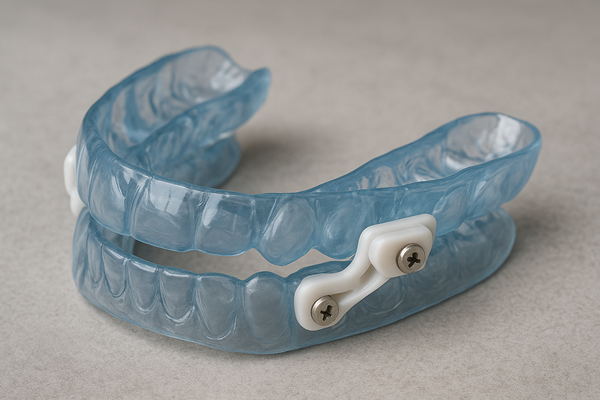When to Replace Your Sleep Apnoea Mouthguard: Signs It’s Time

Sleep apnoea affects millions of people, and, one of the most common ways to prevent it is by using a specialised mouthguard as they sleep. These devices, also known as sleep apnea treatment mouthguards, help keep your airway open while you sleep, improving breathing and reducing snoring.
But like any dental device, a sleep apnea mouthguard doesn’t last forever. Over time, wear and tear can reduce its effectiveness, and using an old or damaged mouthguard can compromise your sleep and oral health. So how do you know when it’s time to replace your mouthguard?
Let’s jump into some of the most common signs that your sleep apnea mouthguard needs replacing and tips for maintaining it to ensure the best results.
Ready to begin?
How Sleep Apnea Mouthguards Work
A sleep apnea mouthguard is a custom device designed to reposition your jaw and tongue while you sleep. By keeping your airway open, it helps prevent the pauses in breathing that characterise sleep apnoea.
Unlike CPAP machines, mouthguards are non-invasive, easy to use, and portable, making them a popular choice for patients with mild to moderate sleep apnoea.
Understanding how your device works helps you appreciate why keeping it in good condition is essential. A worn-out mouthguard may no longer maintain the proper jaw position, reducing its effectiveness.
Typical Lifespan of a Sleep Apnea Mouthguard
The lifespan of a sleep apnea treatment mouthguard depends on the material, how often it is used, and how well it is maintained. On average, most mouthguards last 12 to 24 months before needing replacement.
Custom-fitted mouthguards tend to last longer than over-the-counter options because they are made from durable materials and shaped specifically for your teeth. Regular maintenance, such as cleaning and storing it properly, can also extend its life.
Signs Your Sleep Apnoea Mouthguard Needs Replacing
Even with careful use, there are clear signs that it’s time to get a new mouthguard. Watch out for the following:
1. Visible Wear or Damage
Check your device regularly for cracks, holes, or worn-down areas. Any visible damage can compromise the fit and effectiveness of the mouthguard.
2. Changes in Fit
If your mouthguard feels loose or tight compared to when you first received it, this is a strong indication it no longer fits properly. Changes in your teeth or jaw alignment can affect the fit over time.
3. Increased Discomfort or Pain
A mouthguard should be comfortable to wear. If you start experiencing jaw pain, sore teeth, or gum irritation, your device may need adjusting or replacing.
4. Return of Symptoms
If you notice that your snoring has returned or you’re waking up tired despite wearing your mouthguard, it may not be working as effectively as it used to.
5. Bad Odours or Stains
Persistent bad smells, discoloration, or buildup that cannot be cleaned properly may indicate that the material is degrading. Using a compromised mouthguard can increase the risk of oral infections.
Maintaining Your Sleep Apnea Mouthguard
Proper care can help extend the life of your mouthguard and ensure it remains effective. Here’s how:
Clean It Daily
Rinse your mouthguard with water after each use and brush it gently with a soft toothbrush. Avoid toothpaste, which can be abrasive and damage the material.
Use a Mouthguard Case
Always store your device in a ventilated case to protect it from damage and bacteria.
Avoid Heat
Heat can warp the mouthguard, affecting the fit. Keep it away from hot water, direct sunlight, or heaters.
Regular Check-Ups
Bring your mouthguard to your dentist during routine visits. They can inspect it for wear and ensure it still fits correctly.
Why Regular Replacement Matters
Replacing your sleep apnea mouthguard when needed is important for several reasons:
- Effective Sleep Apnoea Management – A worn or ill-fitting device won’t keep your airway open, reducing its ability to manage your condition.
- Comfort – A properly fitting mouthguard prevents jaw pain, sore teeth, and gum irritation.
- Oral Health – A damaged or old mouthguard can harbor bacteria, increasing the risk of infections.
How Often Should You Replace Your Mouthguard?
While the average lifespan is 1–2 years, individual needs vary. Consider replacing your mouthguard sooner if you notice any of the warning signs above or if your dentist recommends it during a check-up.
Regular inspections and professional advice are the best way to ensure your mouthguard for sleep apnea continues to work effectively.
Look out for signs such as damage, discomfort, poor fit, or a return of symptoms. Timely replacement ensures your mouthguard continues to provide the support you need for better sleep and improved health.
Protect Your Sleep and Oral Health
If you’re using a sleep apnea mouthguard, regular check-ups with Blue Gum Dental can help you maintain its effectiveness and replace it when necessary. Our team can assess your device, check your fit, and make recommendations tailored to your needs.Don’t compromise your sleep or health. Book an appointment with us today to ensure your sleep apnoea mouthguard is working as it should.
